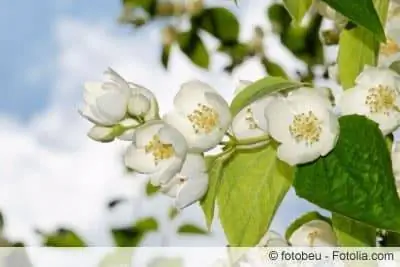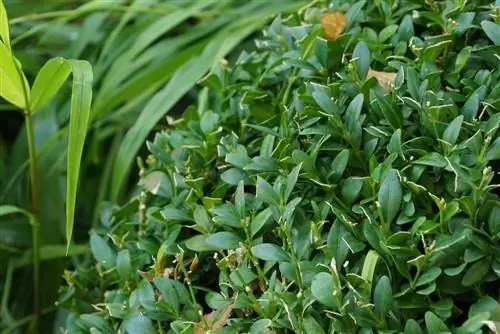- Author admin [email protected].
- Public 2023-12-17 03:39.
- Last modified 2025-06-01 06:48.
Philadelphus doesn't necessarily have to be cut, but sometimes it is recommended. On the one hand, the shrub can become bare from below, and on the other hand, it can simply become too big and wide. On the whole, pipe bushes are very tolerant of pruning and can tolerate heavy pruning. But it is better to proceed with caution.
Short profile of the pipe bush
- Philadelphus
- Also called false jasmine or summer jasmine
- Hydrangea family
- About 60 species
- Native to Italy and Southeastern Europe
- Deciduous shrub, up to 4 m high, but usually not over 2 m
- Upright and slightly overhanging growth
- Light green, elliptical, slightly toothed leaves
- Raceous inflorescences with 5 to 10 flowers
- White flowers with a strong scent, from evening
- Flowering time - early summer
- Capsules
When to cut the pipe bush
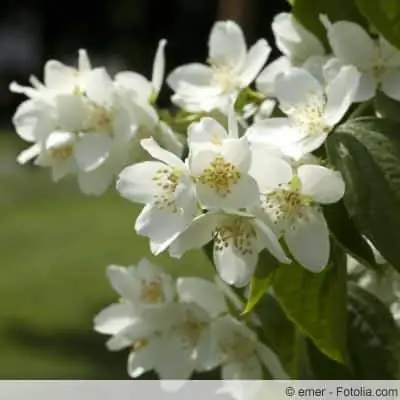
Actually, the pipe bush is neither a real spring nor a summer bloomer. The flowering date is between the end of May and the beginning of June. Early summer would be the correct term. Do you cut the shrub like a spring bloomer after flowering or a summer bloomer in early spring, before budding? The pipe bush does not bloom on the new shoots, but on the two-year-old shoots, i.e. on the previous year's wood, as the experts say. Under no circumstances should you cut in spring, because then the flower heads will be removed. The only time to cut the false jasmine is immediately after it has bloomed, usually at the beginning of July. Shortly afterwards, the flower buds for the next year will be formed, which is why cutting is no longer recommended unless you forego the flowering.
Larger cutting measures should not be postponed to summer, however, as this is unfavorable for the plants. Only carry out small pruning measures in summer. If you plan to prune properly, you should definitely do it during the leafless period. The trees can cope with this much better.
- Time for thinning cut - after flowering
- Major pruning measures - in the leafless period, good in March
Cut
Pipe bushes are usually strong-growing, unless they are specially bred, small-growing varieties. They quickly grow over your head. They also become very dense. It is therefore advisable to thin out something every two to three years. You can start with this around the 4th year. Old wood should be cut out. The shoots hardly have any leaves left and no longer bloom. They have to go so that there is room for new growth from below. In addition, the secondary shoots must be shortened. It's important to cut carefully and not just cut around the shoots as you see fit.
Pruning for rejuvenation
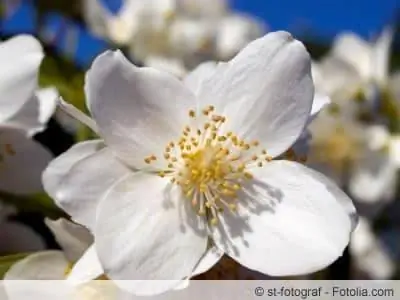
To rejuvenate the pipe bush, it should be cut regularly but moderately. This promotes flower formation and prevents baldness. You start cutting around the 4th year of life and should then use scissors again every 2 to 3 years. The one or two oldest shoots are removed directly at their point of origin, i.e. at the shoot. Cone formation should be avoided. It is crucial to start cutting from the inside, i.e. remove inner shoots at the base. Then you work your way outwards with each cut. Shoot tips are not cut because this leads to unsightly broom growth in the upper part of the bush and to baldness at the base. On the other hand, thinning out the base of the bush or removing old, downward-hanging shoots is effective. In this way, new flowering shoots can form and the natural growth character of the shrub is preserved.
In addition, dry, dead branches and twigs are removed and those that grow strongly inwards or cross or touch each other.
- Cut regularly, but only a little
- Start from the 4th year
- Remove the oldest 2 to 3 shoots at the base
- Create space for new shoots
- Preserve natural growth character
Severe pruning due to lack of space
Pipe bushes are very tolerant of pruning, can also be cut back to the old wood and will sprout again willingly. Even a radical cut is possible. Unfortunately, the bushes no longer look pretty for a long time afterwards, not natural, just as if they had been cut together. Even though false jasmine can be planted on the cane, it should only be done in exceptional cases. When pruning heavily, the shoots are not cut off just above the ground, as is the case with rejuvenation pruning, but rather about 30 cm of wood is left standing. However, over-aged shoots are removed at the base.
Of course, cutting back too radically always harbors dangers. In extreme cases, the entire tree can die. The stress was simply too much for the plant. That's why it's much better to spread the cutting measures over several years.
-
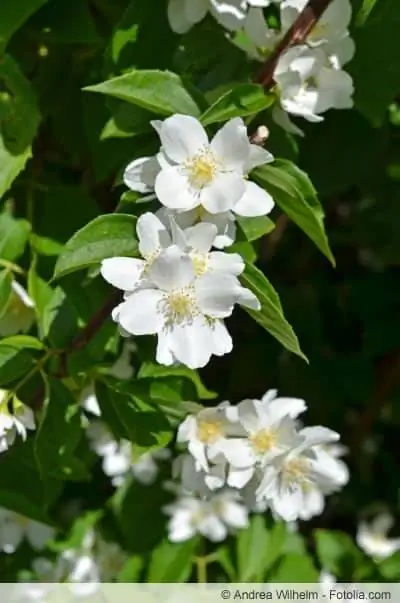
Pipe bush Strong pruning in the leafless period
- March is ideal
- Leave 30 cm of old wood
- Cutting over an outward-facing eye
Pruning to encourage branching
The pipe bush often grows quickly, but looks sparse and unbalanced. Pruning is recommended here so that the tree branches more. The correct cutting date is March, even if you have to do without numerous flowers during the cutting year. It is a good idea to shorten all shoots by about half. The cut is done so that the shoot is removed just above an eye looking outwards.
- Pruning in March
- Short shoots by half
Tip:
Sharp cutting tools are important so that smooth cutting surfaces are created on the wood of the pipe bush. Bruised and/or frayed wounds heal and heal poorly and remain entry points for pathogens for a long time. It is also often recommended to fertilize the pipe bush with phosphorus after cutting.
Conclusion
When cutting the pipe bush, it depends on what you want to achieve with a cut. Scissors are often used to promote branching. The bush should become denser and more shoots bearing the flowers should emerge. Of course, you have to cut it differently than if the pipe bush slowly becomes bald and loses its beautiful growth habit. A third reason for cutting is that the tree has simply become too large and needs to be trimmed. Otherwise, it's best to just let a pipe bush grow without cutting, then it looks most beautiful. When cutting, it is important to stick to deadlines. Small pruning measures that are carried out regularly are done after flowering, while larger ones are done in winter, around March, when there is no longer any risk of major frosts.

